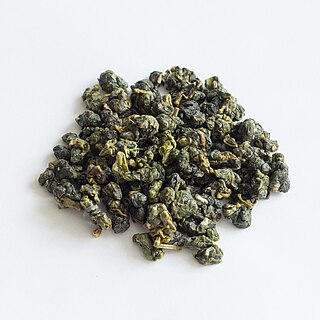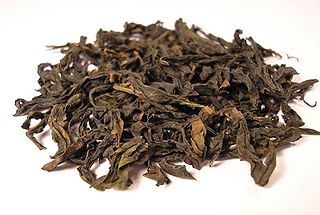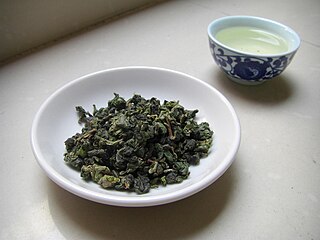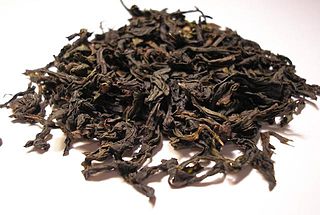 W
WOolong (; simplified Chinese: 乌龙; traditional Chinese: 烏龍 is a traditional semi-oxidized Chinese tea produced through a process including withering the plant under strong sun and oxidation before curling and twisting. Most oolong teas, especially those of fine quality, involve unique tea plant cultivars that are exclusively used for particular varieties. The degree of oxidation, which varies according to the chosen duration of time before firing, can range from 8 to 85%, depending on the variety and production style. Oolong is especially popular in south China and among Chinese expatriates in Southeast Asia as is the Fujian preparation process known as the Gongfu tea ceremony.
 W
WBai Ji Guan or Bai Jiguan is a very light Si Da Ming Cong tea, a well-known oolong tea of Wuyi, in Fujian, China.
 W
WBan Tian Yao is a very rare Wuyi Oolong with a light smokey taste.
 W
WBaozhong tea, sometimes known in English by the older romanization pouchong, is a lightly oxidized tea, twist shape, with floral notes, and usually not roasted, somewhere between green tea and what is usually considered oolong tea, though often classified with the latter due to its lack of the sharper green tea flavours. It is produced mainly in Fujian, China and in Pinglin District, New Taipei, Taiwan.
 W
WBu Zhi Chun is a Wuyi oolong with a light taste.
 W
WDarjeeling tea is a tea made from Camellia sinensis that is grown and processed in the Darjeeling or Kalimpong Districts in West Bengal, India. Since 2004, the term Darjeeling tea has been a registered geographical indication referring to products produced on certain estates within Darjeeling and Kalimpong. The tea leaves are processed as black tea, though some estates have expanded their product offerings to include leaves suitable for making green, white and oolong teas.
 W
WDong Ding, also spelled Tung-ting, is an oolong tea from Taiwan. A translation of Dong Ding is "Frozen Summit" or "Icy Peak", and is the name of the mountain in Taiwan where the tea is cultivated. Those plants were brought to Taiwan from the Wuyi Mountains in China's Fujian Province about 150 years ago.
 W
WFo Shou is a Yongchun and Wuyi Oolong tea with a light and somewhat peculiar taste. It is also produced in Taiwan.
 W
WHigh-mountain tea or gaoshan tea refers to several varieties of oolong tea grown in the mountains of central Taiwan. It is grown at altitudes higher than 1,000 metres (3,300 ft) above sea level, and includes varieties such as Alishan, Dayuling, Yu Shan, Wushe, and Lishan. The high humidity and natural precipitation in the high mountain ranges of Nantou and Chiayi Counties make the region a suitable environment for growing tea plants. High Mountain Oolong is a tea that holds all of its original nutrients that are within the unfermented green tea. It does not hold the usual grass-like taste but due to the fermentation process that removes the harsh ingredients, it allows the tea to taste flavorful.
 W
WHuang Meigui is a very new Wuyi oolong tea, developed c. 2002. It has a highly aromatic fragrance and a lighter floral taste than most other Wuyi oolongs.
 W
WHuang Guanyin tea is a Wuyi oolong with a creamy taste. It can be either tightly rolled like Anxi Oolongs or in strips like conventional Wuyi Oolong.
 W
WHuangjin Gui is a premium variety of Chinese oolong tea traditionally from Anxi in Fujian province. Named after the yellow golden color of its budding leaves and its unique flowery aroma, it is said to be reminiscent of Osmanthus.
 W
WJin Fo tea is a Wuyi Oolong tea, developed at the Wuyi Shan Tea Researching Center located in Fujian Province, China. It is a medium Wuyi Oolong showing both creaminess and a floral aftertaste. The tea leaves have a uniform emerald green colour.
 W
WJin Suo Chi is a very rare Wuyi Oolong with a light taste.
 W
WJin Xuan is a variety of oolong tea developed in 1980. The tea is also known as #12 or as "Milk Oolong". It originates from Taiwan. The taste is light, creamy, and flowery and sometimes compared to milk. This tea variety can be grown at higher altitudes, and the yield is about 20% higher compared to traditional tea varieties. These circumstances made it one of the most popular varieties among tea farmers in Taiwan and Thailand. While genuine Jin Xuan naturally tastes milky, some producers produce artificial Jin Xuan through additives.
 W
WQilan is a very mild Wuyi oolong tea. It has an obvious sweet and nutty aroma.
 W
WRougui tea is a variety of the tea plant, commonly grown in the Wuyi Mountains and processed into oolong tea. The name literally means "cassia". The tea can be difficult to prepare, but its distinctive sweet aroma can be brought out up to 7 steepings. It was first developed during the Qing dynasty.
 W
WShui Jin Gui is a Wuyi oolong tea from Mount Wuyi, Fujian, China. Its name literally means 'golden water turtle'. The tea produces a bright green color when steeped and is much greener than most other Wuyi oolong teas. It is one of the Si Da Ming Cong, the four famous teas of Wuyi.
 W
WShui Xian is an oolong tea from the Wuyi Mountains in Fujian, China with a heavy honey fragrance. Cheaper varieties are grown elsewhere in the province and have a burnt taste and are very popular with Chinese restaurants. The infused color is very dark brown showing that the tea is a very dark Oolong. This tea is also grown in Taiwan.
 W
WSikkim tea is a variety of tea grown in the state of Sikkim, India. Though Sikkim tea is not as widespread in use as the neighboring Darjeeling tea, it has recently gained more recognition from the increasing demand for organic products. The tea is mostly sold under the marketing name 'Temi tea'. After Darjeeling tea became the first Indian product to receive a GI tag, Sikkim's Temi tea has been waiting to receive the same.
 W
WTieguanyin is a variety of Chinese oolong tea that originated in the 19th century in Anxi in Fujian province. Tieguanyin produced in different areas of Anxi have different gastronomic characteristics.
 W
WWuyi tea, formerly known by the trade name Bohea in English, is a category of black and oolong teas grown in the Wuyi Mountains of northern Fujian, China. The Wuyi region produces a number of well-known teas, including Lapsang souchong and Da Hong Pao. It has historically been one of the major centers of tea production in Fujian province and globally. Both black tea and oolong tea were likely invented in the Wuyi region, which continues to produce both styles today.